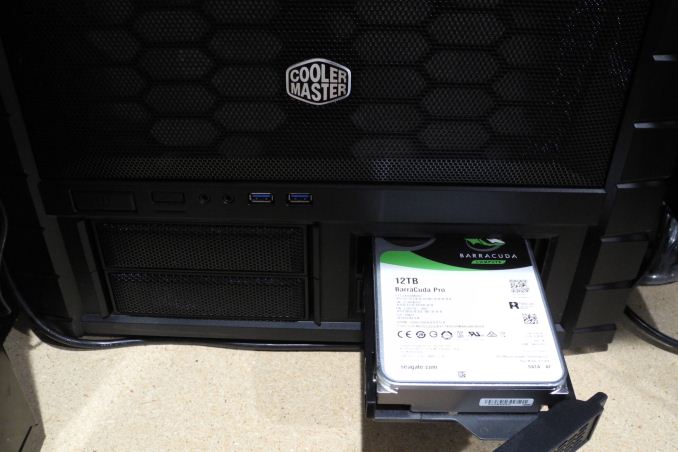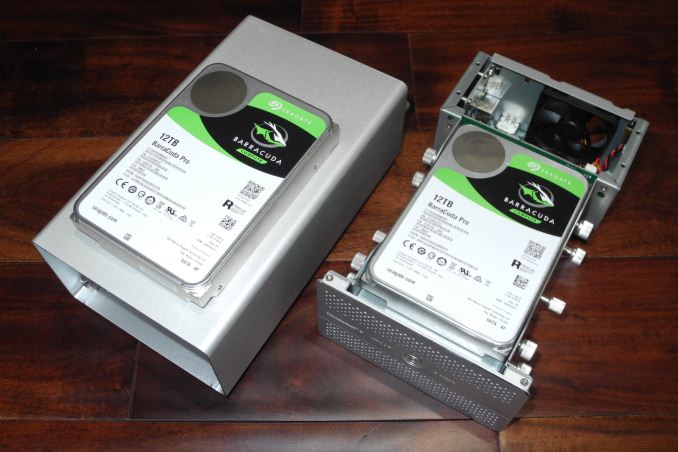Seagate BarraCuda Pro 12TB HDD Review
by Ganesh T S on November 15, 2017 8:00 AM EST- Posted in
- Storage
- Seagate
- HDDs
- Helium HDD
Concluding Remarks
The BarraCuda Pro 12TB is a unique product in the market. It is not often that we see a leading capacity 'desktop-class' hard drive rated for 24x7 operation or workload ratings of 300TB/year. To top it all, Seagate is even throwing in a 5-year warranty. A 2-year data recovery service (DRS) is also included. The lower load/unload cycles rating (300K, compared to the 600K in the equivalent NAS drives) and MTBF (1M hours, compared to 1.2M for the equivalent Pro NAS drive) are slightly disappointing aspects, but, they are more than made up for by the warranty and DRS.
In the gaming desktops market in particular, we are seeing per-game storage requirements running into 100s of GBs, and SSDs continuing to remain above $0.33/GB. Under these circumstances, high-capacity hard drives are bound to become relevant again. In our evaluation, the drive managed to perform quite well for largely sequential workloads (typical of bulk storage requirements in gaming workloads).
Consumers dealing with content creation can also use the BarraCuda Pro as part of a direct-attached storage system. For single-user scenarios, a DAS inherently makes more sense than a NAS. It allows use of enclosures sporting interfaces with higher speeds. The BarraCuda Pro 12TB drive shows great performance in such devices.
In our evaluation, the drive successfully met all of Seagate's claims. Helium drives have achieved economies of scale and are now mass-market devices. The current street price of the BarraCuda Pro 12TB ($500) is already lower than the suggested launch price ($530). The other 12TB Seagate options are the IronWolf NAS drive at $450, IronWolf Pro at $510, and the Enterprise Capacity at $469. We also have the Western Digital WD Gold at $522. The IronWolf has a lower workload rating (180 TB/yr vs 300 TB/yr) and also doesn't have the data recovery service available with the BarraCuda Pro and the IronWolf Pro. None of the enterprise drives carry the DRS option, which justifies the premium associated with the two Seagate Pro drives.
Pricing the BarraCuda Pro mid-point between the IronWolf and the IronWolf Pro would have made it an obvious choice for a high-capacity desktop / DAS usage drive. As it currently stands, it is difficult to choose between the IronWolf Pro and the BarraCuda Pro, as only $10 separates them. The IronWolf Pro also has a higher load/unload cycle rating. Seagate claims that the firmware in the BarraCuda Pro is tuned specifically for typical high-end desktop workloads. However, it is unlikely that consumers will see obvious performance differences between the two drives in typical single-user scenarios. In the end, the DRS ensures that customers are unlikely to go wrong with either the IronWolf Pro or the BarraCuda Pro, irrespective of the end application.












62 Comments
View All Comments
Glock24 - Wednesday, November 15, 2017 - link
Who wants to lose 12TB of data? Yeah, not me.kingpotnoodle - Wednesday, November 15, 2017 - link
That is why RAID was invented and backup should be routine.Only a fool stores their important data without disk redundancy and/or backup, whether they have 12KB or 12TB of it. Doesn't matter how much important data you have, if you don't want to lose it then don't entrust it to a single drive.
tipoo - Wednesday, November 15, 2017 - link
Storage getting cheaper = backup getting cheaper. This has been true always.imaheadcase - Wednesday, November 15, 2017 - link
You be surprised how much data you DON'T need.PeachNCream - Wednesday, November 15, 2017 - link
Yeah from someone thats had a hard drive with pretty much my entire life saved on it (and without a current backup *sniff*) I can say there's a lot of data you can live without. Well all of it, but it is a pain to lose things.MobiusPizza - Wednesday, November 15, 2017 - link
Yeah, that's why I have 4 RAID 5 drives plus cloud backup for my terabytes of porn, I meant important dataGreenReaper - Sunday, September 2, 2018 - link
Funny - I run a porn site on 4 2TB RAID-5 drives. And another four in a mostly-live backup. And another 4TB one off-site. (Plus all the caches.)Thankfully most of it is pictures, not video, or they'd need to be 12 12TB drives - or maybe a cluster.
GreenReaper - Sunday, September 2, 2018 - link
Also: disks really do die. We've had four or five go over eight years - thankfully, none at once. You'd better be sure you have a backup - even at +200MBps you're talking 16 hours to rebuild 12TB, assuming *no* other I/O, and let's be honest: if you didn't have I/O you probably wouldn't need RAID. Realistically, it's likely to take a day; with heavy I/O, maybe a week. Consider using only up to about the first 2/3 and migrating to a 24TB drive array (once they exist).fzzzt - Wednesday, November 15, 2017 - link
This is why backups are used. RAID is not a replacement for a backup.Lord of the Bored - Wednesday, November 15, 2017 - link
A fool and his data are soon parted, as it were.